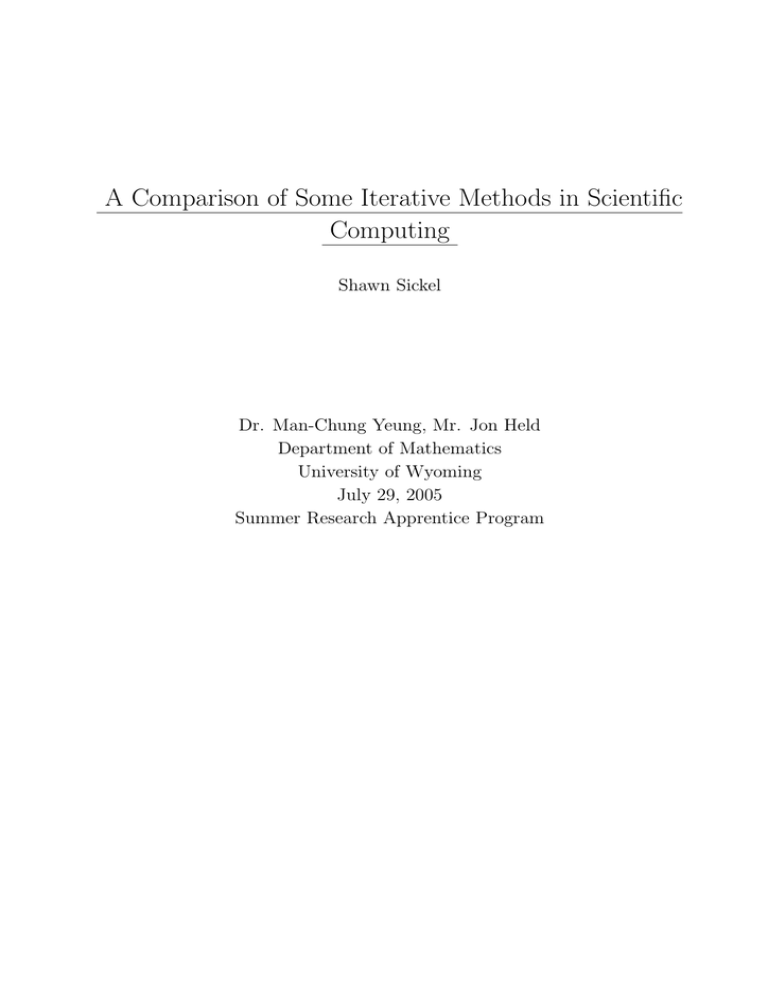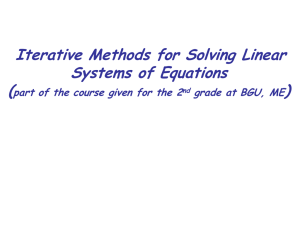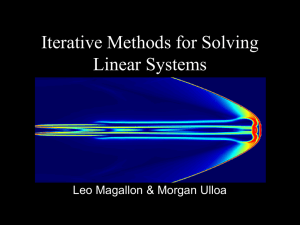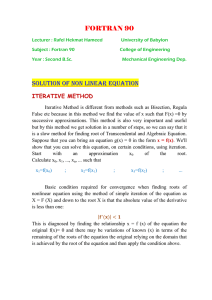A Comparison of Some Iterative Methods
advertisement

A Comparison of Some Iterative Methods in Scientific
Computing
Shawn Sickel
Dr. Man-Chung Yeung, Mr. Jon Held
Department of Mathematics
University of Wyoming
July 29, 2005
Summer Research Apprentice Program
Abstract
Linear systems Ax = b arose from industrial applications are usually large and sparse. It
is very common that those systems involve millions of unknowns. Some basic solution methods
that we learned in high-school classes, for example, Gaussian Elimination, do not work in finding
the solutions of linear systems of such large size since they are too slower and require huge
storage spaces. The most popular methods nowadays used in industry are iterative methods.
In this paper, we selected and studied some iterative methods. Our experimental results show
that Krylov subspace iterative methods are generally faster than the basic iterative methods.
Among Krylov subspace iterative methods, Conjugate Gradient method is the best if A is
symmetric and positive definite(SPD). When A is not SPD, but AH is available, Bi-Conjugate
Gradient method is then the best choice for the solution of the linear system. In the case where
AH is not available, Bi-Conjugate Gradient Stabilized method should be used.
Acknowledgement
For the success in my paper, I would like to thank my fellow SRAPers and the SRAP staff
for encouragement and support. I would not have been able to complete this research paper
without the help and guidance of Man-Chung Yeung and Jon Held. They taught me how to
use Matlab computer programming, they helped edit my paper, and they showed me how the
different iterative methods work.
Contents
1 Introduction
1
2 Iterative methods and experiments
2.1 Basic iterative methods . . . . . . . . . . . . . . . . .
2.1.1 Jacobi method and Gauss-Seidel method . . .
2.1.2 Convergence of a basic iterative method . . .
2.1.3 Numerical experiments . . . . . . . . . . . . .
2.2 Krylov subspace methods . . . . . . . . . . . . . . .
2.2.1 Conjugate gradient method (CG) . . . . . . .
2.2.2 Bi-conjugate gradient method (BiCG) . . . .
2.2.3 Bi-conjugate gradient stabilized (BiCGSTAB)
2.2.4 Numerical experiments . . . . . . . . . . . . .
1
2
2
3
3
5
5
6
6
7
3 Conclusion
.
.
.
.
.
.
.
.
.
.
.
.
.
.
.
.
.
.
.
.
.
.
.
.
.
.
.
.
.
.
.
.
.
.
.
.
.
.
.
.
.
.
.
.
.
.
.
.
.
.
.
.
.
.
.
.
.
.
.
.
.
.
.
.
.
.
.
.
.
.
.
.
.
.
.
.
.
.
.
.
.
.
.
.
.
.
.
.
.
.
.
.
.
.
.
.
.
.
.
.
.
.
.
.
.
.
.
.
.
.
.
.
.
.
.
.
.
.
.
.
.
.
.
.
.
.
.
.
.
.
.
.
.
.
.
8
1
Introduction
Iterative methods for solving general, large, sparse linear systems have been gaining popularity
in many areas of scientific computing. This is due in great part to the increased complexity and
size of the new generation of linear and nonlinear systems that arise from typical applications.
At the same time, parallel computing has penetrated the same application areas, as inexpensive
computer power has become broadly available and standard communication languages such as
MPI have proved a much needed standardization. This has created an incentive to utilize
iterative rather than direct solvers, e.g., Gauss Elimination, because the problems solved are
typically from three or more dimensional models for which direct solvers often become ineffective
due to the huge sizes of the resulting linear systems. Another incentive is that iterative methods
are far easier to implement on parallel computers (see [4]).
Iterative methods nowadays can be divided into three groups: 1. basic iterative methods,
2. Krylov subspace methods, 3. Multigrid methods. In this paper, we will compare the
performances through numerical experiments of the first two groups of methods. The numerical
experiments will be done based on the test data from industry — we will download the test
data from the government website http://math.nist.gov/MatrixMarket/data where industrial
companies often post their test data.
The outline of the paper is as follows. In §2, we select some representative iterative methods
and compare them through experiments. More precisely, we consider two famous basic iterative
methods, Jacobi and Gauss-Seidel, in §2.1 and we think about three Keylov subspace methods:
CG, BiCG and BiCGSTAB in §2.2. We end the paper with some conclusions based on our
experimental results in §3.
2
Iterative methods and experiments
Consider the solution of
Ax = b,
(1)
where A ∈ C N ×N is a large, sparse matrix. In practice, when the coefficient matrix A is sparse,
people always use iterative methods rather than direct methods, say, Gaussian Elimination(GE),
for the solution of (1). The reason is that, GE needs to perform two steps to solve (1):
1. decompose A as A = LU where L is lower triangular and U is upper triangular;
2. solve Ly = b and Ux = y by forward and backward substitutions, respectively.
However, even though A is sparse, the resulting L and U are usually dense. If one uses GE to
solve (1), one needs to store the L and U for the forward and backward substitutions in step
#2. Therefore, the storage requirement of GE is 21 N 2 + 12 N 2 = N 2 of floating point numbers.
This is a huge memory requirement since it is not unusual in industry that N = 109 , and hence
N 2 = 1018 which is out of the storage capacity of all the computers nowadays.
Iterative methods, on the other hand, are cheap in storage. The typical operation in an
iterative method is a matrix times a vector, Gv. The G is usually constructed from A and is
sparse. Hence G occupies only a little memory in a computer. Therefore, the memory required
1
to implement an iterative method is a very limited and that is why this kind of methods is so
popular in practice when solving large, sparse linear systems.
Iterative methods nowadays can be divided into three groups:
i) basic iterative methods;
ii) Krylov subspace methods;
iii) Multigrid methods.
In this paper, we will only discuss and compare some of the methods from the first two groups
through numerical experiments.
2.1
Basic iterative methods
There exist many basic iterative methods, see, for instance, [2] and [4]. In this section, we study
two of them: Jacobi method and Gauss-Seidel method.
2.1.1
Jacobi method and Gauss-Seidel method
To solve the linear system (1), split A as
A=D−E−F
where D, E and F are the diagonal, strictly lower triangular and strictly upper triangular parts
of A. Then (1) becomes
(D − E − F)x = b.
(2)
From (2), we then have
x = D−1 (E + F)x + D−1 b.
Replace the x on the right by x(k) , the approximate solution at iteration step k, and the x on
the left by x(k+1) , the approximate solution at iteration step k + 1, we then have the Jacobi
method
x(k+1) = D−1 (E + F)x(k) + D−1 b.
To obtain Gauss-Seidel method, write (2) as
(D − F)x = Ex + b.
Replace the x on the right with x(k) and the x on the left with x(k+1) :
(D − F)x(k+1) = Ex(k) + b.
So,
x(k+1) = (D − F)−1 Ex(k) + (D − F)−1 b
and this is called Gauss-Seidel method.
2
2.1.2
Convergence of a basic iterative method
In general, a basic iterative method always has the form
x(k+1) = Gx(k) + f
(3)
where G is a matrix and f is a vector. Compared to (3), the G for Jacobi method is
G = D−1 (E + F)
and the G for Gauss-Seidel method is
G = (D − F)−1 E.
Theoretically, it can be proved that a basic iterative method (3) will approach the exact solution
x∗ of (1) if ρ(G) < 1, namely, x(k) will tend to x∗ as k becomes larger and larger if ρ(G) < 1.
This is a result stated by the following theorem from Saad’s book[4, p.112].
Theorem 2.1 If ρ(G) < 1 where ρ(G) denotes the largest eigenvalues of G in absolute value,
then the iterative method (3) converges for any f and any x0 . Moreover, the smaller the ρ(G)
is, the faster the iterative method (3) will converge.
2.1.3
Numerical experiments
Consider the problem of solving the following linear system:
α −1
−1 α −1
... ... ...
... ... ...
−1 α −1
−1 α
x
1
1
x
1
2
.
.
.
.
. = .
.
.
..
.
.
.
xN
1
for α = 1, 2 and 3. The corresponding ρ(G) for Jacobi and Gauss-Seidel methods are as follows:
α
|
ρ(G) of Jacobi
|
ρ(G)of Gauss-Seidel
− − − − − − − − − − − − −− − − − − − − − − − − − − − −
1
|
1.9990
|
3.9961
2
|
0.9995
|
0.9990
3
|
0.6663
|
0.4440
Using this 100×100 matrix, we have computed the separate largest eigenvalues in absolute
for each of the basic iterative methods that we are studying and listed them in the above table.
Having looked at the corresponding eigenvalues between the Jacobi method and the GaussSeidel method, we found that ρ(G) is smaller for the Gauss-Seidel method when α = 2, 3,
proving that Gauss-Seidel converges faster according to Theorem 2.1 (see Figures #2 and
#3). Another reason why the Gauss Seidel method is faster is because it uses more updated
3
convergence values to find better guesses than the Jacobi method. For α = 1, both methods
diverge since their ρ(G) are greater than 1 (see Fig #1).
300
10
250
10
200
150
10
100
10
50
Gauss−Seidel: solid
10
Jacobi: dot
0
10
0
100
200
300
400
500
600
iteration (Fig 1)
700
800
900
1000
Gauss−Seidel vs Jacobi, alpha = 2
−0.1
10
relative error
relative error
10
−0.2
10
−0.3
10
Gauss−Seidel: solid
−0.4
Jacobi: dot
10
0
100
200
300
400
500
600
iteration (Fig 2)
4
700
800
900
1000
Gauss−Seidel vs Jacobi, alpha = 3
0
10
−1
10
−2
10
−3
relative error
10
−4
10
−5
10
−6
10
Gauss−Seidel: solid
−7
Jacobi: dot
10
−8
10
2.2
0
5
10
15
20
iteration (Fig 3)
25
30
35
40
Krylov subspace methods
Basic iterative methods can not solve all the linear systems. In fact, if ρ(G) < 1, a basic
iterative method will fail. In this section, we will study a second group of iterative methods,
Krylov Subspace methods. The idea behind a Krylov subpace method is that, at iteration step k,
the method searches a “good” approximate solution to the linear system (1) from the following
subspace
span{b, Ab, A2 b, · · · , Ak−1 b}.
In mathematics, people call the above subspace Krylov subspace, and therefore, the corresponding methods are called Krylov subspace methods.
2.2.1
Conjugate gradient method (CG)
Conjugate gradient method[3] is the first Krylov subspace method in the history which is
designed only for solving symmetric positive definite (SPD) linear system Ax = b, namely, the
coefficient matrix A satisfies i) AH = A; ii) xH Ax > 0 for any x 6= 0. If the linear system is
not SPD, the CG method will fail to converge.
Two professors from UCLA created this method in 1952. Here is the algorithm[4, p.190]:
Conjugate Gradient Iterative Method
Set r0 = b − Ax0 , p0 = r0
For k = 1, 2, · · ·
H
αk−1 = rH
k−1 rk−1 /pk−1 Apk−1 ;
xk = xk−1 + αk−1 pk−1 ;
rk = rk−1 − αk−1 Apk−1 ;
H
βk−1 = rH
k rk /rk−1 rk−1 ;
pk = rk + βk−1 pk−1 ;
End
5
2.2.2
Bi-conjugate gradient method (BiCG)
Then, a natural question that you may ask is that, if we are given a non-SPD system, is there
any Krylov subspace method to find the solution to the linear system? The answer is Yes. The
following Krylov iterative method is called Bi-Conjugate Gradient Method, which can solve any
linear system and was created by a mathematician named Fletcher[1] in 1974. The following
algorithm was copied from Saad’s book[4, p.223].
Bi-Conjugate Gradient Iterative Method
Set r0 = b − Ax0 . Choose r∗0 such that (r∗0 )H r0 6= 0.
Set p0 = r0 , p∗0 = r∗0 .
For k = 1, 2, · · ·
∗
H
H ∗
αk−1 = rH
k−1 rk−1 /pk−1 A pk−1 ;
xk = xk−1 + αk−1 pk−1 ;
rk = rk−1 − αk−1 Apk−1 ;
r∗k = r∗k−1 − αk−1 AH p∗k−1 ;
∗
H
∗
βk−1 = rH
k rk /rk−1 rk−1 ;
pk = rk + βk−1 pk−1 ;
p∗k = r∗k + βk−1 p∗k−1 ;
End
2.2.3
Bi-conjugate gradient stabilized (BiCGSTAB)
In some applications, we want to solve Ax = b, but we do not know the matrix A. What we
know is that, given us a vector v, we can have Av through some other methods. Hence we can
know the result Av, but have no way to know AH v. Therefore, BiCG is not applicable in such
situations.
The following algorithm can solve any linear system, but not involves AH in its implementation. The algorithem is called Bi-Conjugate Gradient Stabilized method and was created by
van der Vorst[5] in 1992. We copied the algorithm from Saad’s book[4, p.234].
BiCGSTAB
Set r0 = b − Ax0 . Choose r∗0 .
Set p0 = r0 .
For k = 1, 2, · · ·
H ∗
∗
αk−1 = rH
k−1 r0 /(Apk−1 ) r0 ;
sk−1 = rk−1 − αk−1 Apk−1 ;
ωk−1 = (Ask−1 )H sk−1 /(Ask−1 )H Ask−1 ;
xk = xk−1 + αk−1 pk−1 + ωk−1 sk−1 ;
rk = sk−1 − ωk−1 Ask−1 ;
βk−1 =
∗
rH
k r0
∗
rH
r
k−1 0
×
αk−1
;
ωk−1
pk = rk + βk−1 (pk−1 − ωk−1 Apk−1 );
End
From the algorithm, we can that it only involves the computation Av, no AH v.
6
2.2.4
Numerical experiments
The GS method only converges when ρ(G) < 1. For a large matrix, GS has many more
iterations than the CG method does. Figure 4 shows the convergence of both methods, where
the test matrix is a 2003 × 2003 structural engineering matrix labeled bcsstk05 from the group
BCSSTRUC1, Harwell-Boeing collection. We can see that, when solved by the CG method, it
converged after about 300 iterations, whereas the GS method has yet to converge after 1600
iterations. GS is slow to converge because ρ(G) = 0.9986, very close to 1. As long as the
matrix is SPD, the CG method will be faster than the GS method, because the CG method is
approximating the solution using the span of the subspace, and must converge within N steps,
where N is the size of the matrix.
For CG to work, the matrix A must be a SPD matrix. Figure 5, a chemical kinetics
RCHEM radiation study matrix labeled fs 680 1 from the group FACSIMILE of Harwell-Boeing
collection, is a 680 × 680 matrix. BiCG is used to solve the asymmetrical linear systems, while
CG can only solve SPD matrices and this is why CG can not converge in this experiment and
is going up instead of down.
BiCGSTAB is basically BiCG, but does not require the A-transpose AH in its implementation, so it maybe somewhat slower, but can still solve linear systems that BiCG can not —
in some applications, we only know A without knowing AH . Figure 6, using the same matrix
from Figure 5, shows the slight difference in BiCG and BiCGSTAB’s convergence rates.
Conjugate gradient method compared to Gauss−Seidel
1
10
CG: solid
0
Gauss−Seidel: dot
10
−1
10
−2
relative error
10
−3
10
−4
10
−5
10
−6
10
−7
10
−8
10
0
200
400
600
800
1000
iteration (Fig 4)
7
1200
1400
1600
CG vs. BiCG
20
10
15
10
10
relative error
10
5
10
0
10
BiCG: solid
−5
10
CG: dot
−10
10
0
100
200
300
400
iteration (Fig 5)
500
600
700
BiCG vs. BiCGSTAB
6
10
4
BiCGSTAB: solid
10
BiCG: dot
2
relative error
10
0
10
−2
10
−4
10
−6
10
−8
10
3
0
100
200
300
iteration (Fig 6)
400
500
600
Conclusion
In this paper, we have looked over basic iterative methods and krylov subspace methods. Among
these, our goal was to find out which was the most efficient under certain conditions. Basic
iterative methods, such as the Gauss-Seidel method and the Jacobi method represent the first
steps into solving linear systems with iterations.
The test data was taken from Matrix Market, at http://math.nist.gov/MatrixMarket/.
Bcsstk05 is the page with the data used. The Jacobi and Gauss-Seidel methods both have the
same properties as to what makes it converge faster or indefinable. If ρ(G) > 1, the basic
iterative methods will not converge. The close the p(G) is to 1, the slower it will converge.
8
The Gauss-Seidel method has a lower value of p(G) than the Jacobi method does, so that the
Gauss-Seidel method converges faster.
The CG method requires the matrix to be a SPD, a Symmetrical Positive Definite matrix.
This method uses the span not just the guesses of the previous guess step. It is considerably
faster than the Gauss-Seidel method, and has a maximum of N steps to converge for an N × N
matrix. Gauss-Seidel on the other hand, will have many more iterations at larger dimensions.
CG and BiCG are two different methods for two different situations. Depending on the
givens, the one of the equations is useless. For example, If the matrix is not an SPD matrix,
then CG will not converge, so BiCG must be used. If the matrix is SPD, though, CG must be
used since CG is cheaper in computational cost per iteration than BiCG.
BiCGSTAB is needed because in real life situations, The A-Transpose might not always
be a given component in solving the linear systems. BiCGSTAB does not converge as fast as
BiCG, but BiCGSTAB will converge without the transpose.
References
[1] R. Fletcher, IConjugate gradient methods for indefinite systems, in Proceedings of the
Dundee Biennial Conference on Numerical Analysis, 1974, G. A. Watson, ed., SpringerVerlag, New York, 1975, pp. 73-89.
[2] W. Hackbusch, Iterative solution of large sparse systems of equations, Springer-Verlag,
New York, 1994.
[3] M. R. Hestenes and E. L. Stiefel, Methods of conjugate gradients for solving linear
systems, Journal of Research of the National Bureau of Standards, Section B, 49(1952),
pp. 409-436.
[4] Y. Saad, Iterative methods for sparse linear systems, 2nd edition, SIAM, Philadelphia,
PA, 2003.
[5] H. A. van der Vorst, Bi-CGSTAB: A fast and smoothly converging variant of Bi-CG
for the solution of nonsymmetric linear systems, SIAM J. Sci. Statist. Comput., 12 (1992),
pp. 631–644.
9





